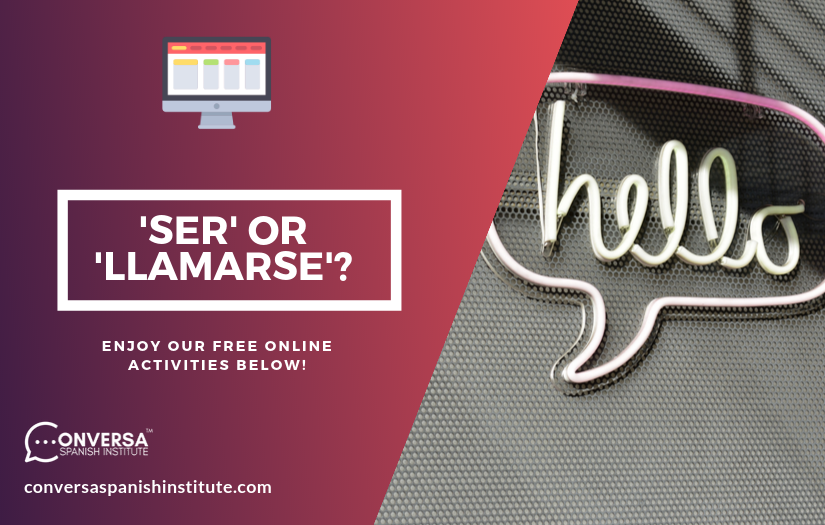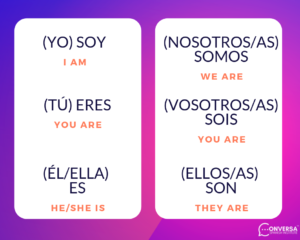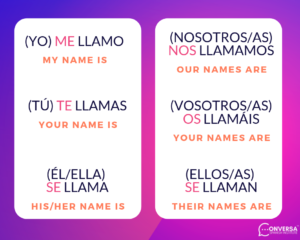- [email protected]
- +34 961258767
- Av. del Marqués de Sotelo 3, Floor 2, Door 4, 46002 Valencia
Centre accrédité par l'Instituto Cervantes
Centre accrédité par l'Instituto Cervantes

Dans les entrées précédentes, nous avons parlé de comment se présenter en espagnol et plusieurs phrases que tu peux utiliser pour commencer une introduction réussie. Aujourd'hui, cependant, nous allons aller un peu plus loin et nous familiariser avec les grammaire behind introductions. Let’s review the Spanish verbs “ser” and “llamarse”.
Comme en anglais, les structures les plus courantes sont les suivantes “soy” (Je suis) ou “me llamo” (Je m'appelle). C'est très simple. Mais que se passe-t-il si tu veux demander à l'autre personne son nom ? Ou si tu veux présenter quelqu'un d'autre ? Pour cela, tu devras connaître toutes les formes de ces verbes.
If you are learning Spanish you probably know that verbs are trickier than in English. The verb “ser” (pour être) is irregular and its form varies considerably depending on the subject (I, you, them, etc). “Llamarse” (literally à appeler), on the other hand, is a regular verb, so if you know the word endings for regular verbs, you won’t find much difficulty. But it is a reflexive verb, meaning it comes with the pronoun “se” which also changes. Don’t worry if you find this explanation a bit confusing, we will explain in detail how verbs work in Spanish soon, so let’s now focus on Ser vs Llamarse.
Comme mentionné plus haut, ce sont les phrases habituelles que nous pouvons utiliser :
So what if you want to introduce someone else? Well let’s see all the forms:


NOTE : Now, we have talked about “llamarse” as “to be called”, but since this is not a structure that you typically find in English, the most fitting translation is “my/your/her… name is”.
Si tu te demandes pourquoi les pronoms sujets (je, tu, etc) sont entre parenthèses, c'est parce qu'ils ne sont pas nécessaires, nous comprenons de qui il s'agit par le... verbe se terminer.
Par exemple, une introduction très simple entre trois personnes pourrait se dérouler comme suit :
Comme tu peux le constater, there isn’t really a difference in meaning or style between the verbs “ser” and “llamarse”. Both are perfectly adequate in any situation. Maybe “¿Cómo te llamas?” is more appropriate than “who are you?”, as the meaning behind “llamarse” is specific to names and that question may sound rude, depending on the tone or situation.
Did you get any of that? Give yourself time, and you’ll master Spanish in the blink of an eye!
Don’t forget to practice with this Activité en ligne gratuite et continue à apprendre l'espagnol !
| Cookie | Duración | Descripción |
|---|---|---|
| cookielawinfo-checkbox-analytics | 11 mois | Ce cookie est défini par le plugin GDPR Cookie Consent. Le cookie est utilisé pour stocker le consentement de l'utilisateur pour les cookies de la catégorie "Analytics". |
| cookielawinfo-checkbox-fonctionnel | 11 mois | Le cookie est défini par le GDPR cookie consent pour enregistrer le consentement de l'utilisateur pour les cookies de la catégorie "Fonctionnel". |
| case à cocher nécessaire pour le droit de la concurrence | 11 mois | Ce cookie est défini par le plugin GDPR Cookie Consent. Il est utilisé pour stocker le consentement de l'utilisateur pour les cookies de la catégorie "Nécessaire". |
| cookielawinfo-checkbox-autres | 11 mois | Ce cookie est défini par le plugin GDPR Cookie Consent. Ce cookie est utilisé pour stocker le consentement de l'utilisateur pour les cookies de la catégorie "Autres". |
| cookielawinfo-checkbox-performance | 11 mois | Ce cookie est défini par le plugin GDPR Cookie Consent. Ce cookie est utilisé pour stocker le consentement de l'utilisateur pour les cookies de la catégorie "Performance". |
| politique_cookie_vu | 11 mois | Le cookie est défini par le plugin GDPR Cookie Consent et est utilisé pour enregistrer si l'utilisateur a consenti ou non à l'utilisation de cookies. Il ne stocke aucune donnée personnelle. |
Remplis le formulaire ci-dessous et notre équipe d'admission te répondra dans les 24 à 48 heures.